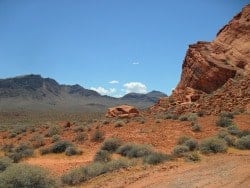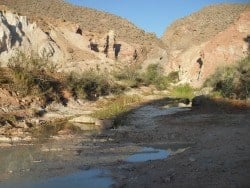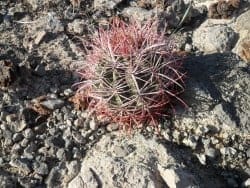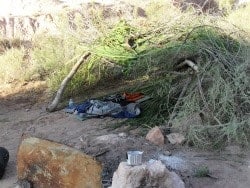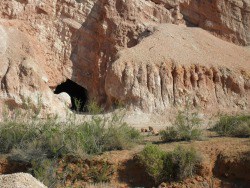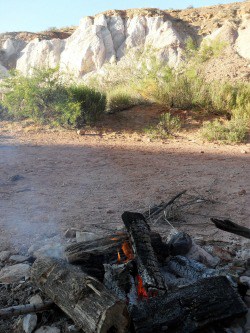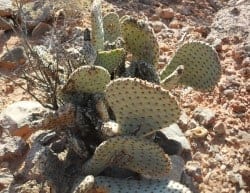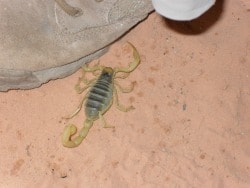Having just returned home from teaching a survival course in the deserts of Nevada, and given the parts of the
This article is Part 2 in a series on Wilderness Survival (Read Part 1)
SKIP AHEAD
Priorities of Desert Survival
As with any survival situation, should you find yourself stranded suddenly in the desert, the very first thing is to avoid panic and calmly address your situation. Use S.T.O.P., or Sit, Think, Observe, and Plan to calm down, consider your situation, assess resources and surroundings, and come up with a pertinent plan to take efficient, necessary steps towards ensuring your survival. Use the Rule of Threes to prioritize your plan of action in order of your most crucial resources.
To learn more about S.T.O.P. and the Rule of Threes, click here.
1. Water
Deserts are known for their extreme lack of water, making it your most precious resource of all. In a prepared
When the time comes to drink, consume a reasonably sufficient amount, as taking in a larger quantity is the only efficient way to rehydrate vital organs. Taking tiny sips over an extended time period does not accomplish this, resulting in dehydration. Excess consumption will result in water being secreted and thus wasted. Despite that they are scarce, there are sources of water in the desert; one must simply become efficient at methods of finding and identifying them. The presence of any green vegetation is an instant indicator of an oases or water hole, which will often provide not only a reliable source of water, but of potential food as well. The presence of any large mammal, or a series of converging animal trails are generally good indicators that a viable water source is within a day’s reach.
Also Read: 6 Dangerous Urban Legends About Water
One can sometimes access underground water tables via a hole or well. These wells can sometimes be very deep,
In deserts where temperatures fluctuate greatly at night, such as the Sahara, the Gobi, the deserts of Peru and Chile, and the Middle East, one can exploit the evening’s low temperatures to produce condensation that can be harnessed as a water source.
Plants, such as various cacti, as well as plant roots, can also be exploited for water, although without the aid of a
2. Shelter and Clothing
Retaining the water you already have is every bit as important as finding more. Therefore, you must learn to
Also Read: Making Fire With A Bow Drill
Be cognizant of the effort required and resulting water loss of any activity, and carefully gauge whether the gain is worth the precious water lost. Move and exert yourself as little as possible, and limit your activities to the cooler times of dusk and evening. If available, make use of your surroundings, such as rock outcrops or caves that provide natural shade and shelter. Be cognizant of any creatures that may be living there already. Rock piles can be constructed to block high winds.
Avoid lying directly on the hot ground. When possible, build an elevated bed for additional air circulation. If you are using tarps or fabrics, additional circulation can be achieved by opening the bottoms during the day, and closing them at night to preserve warmth. If you are stranded in the desert on account of a car or plane issue, DO NOT take refuge in the vehicle, as they heat quickly. Take advantage instead of its form and resulting shade to build an adequate shelter. Do not hesitate to use materials from the vehicle if it will help to ensure your survival.
Many desert animals build burrows below the sand, allowing them to remain cooler during the day and warmer at
Properly dressing for the desert is an integral part of sheltering oneself as well. Hot climates instantly cause many to reach for shorts and t-shirts, leaving themselves open to extra water loss and the blistering sun and sand. Loose, long sleeved clothing with enough space to create an air pocket to insulate is ideal for cooling, and provides far better sweat management. Anything that can further cover the head, face and neck, such as a swathe of cloth, a bandanna, or a wide brimmed hat is also essential.
3. Fire
As with any survival situation, fire will be essential for warmth, company, water purification, cooking, and
If stranded due to a vehicle crash or failure, one can effectively create a fire by first filling a container with sand. Next, pour gasoline or oil in with the sand and light, creating a controlled fire that will burn efficiently. A spark caused by crossing the negative and positive terminals of a car battery can also provide an effective method for lighting a fire, as does using a mirror or glasses to concentrate the sun’s powerful rays.
4. Signaling and Self-Rescue
The best option in the desert, particularly if shelter and resources are available, is to stay put, and take every step to make oneself easy to find for potential rescuers. Take care to make your shelter and presence as visible as possible to potential rescuers. Signal fires and large indicators, such as HELP or SOS carved into the sand are instrumental in aiding your rescue. If stranded with a plane, remain with or near it at all costs, as the black box’s locator beacon should draw rescuers to your exact location. The rubber on a broken down car tire can be burned to create massive billows of black smoke.
Also Read: Survival Radio
If forced to self-rescue, the distance you will be able to cover will be directly related to the amount of water available. A rough estimate, in 120 degree weather and based off an individual traveling only at night, and resting for the entire day, one might reasonably cover 35 miles on 2 liters, in roughly three days before collapse. That time is not likely to increase unless water supply more than doubles, barring exceptions. In all but the most extreme cases, when rescue is impossible or staying still holds your life in imminent danger, it is best to remain within reach of safety and resources and wait for rescue.
5. Food
Despite the unpleasant aspects of hunger, food is at the very bottom of the priority list in the desert. The extreme heat often suppresses appetite, which, in certain regards, can be advantageous to a degree. In desert situations it can actually be detrimental to eat too much, on account of the additional water the body will require to aid in digestion.
In the event that one must eat, do so with caution and ration well. Any animal that can be foraged, trapped, or
Plans can be utilized as food sources as well. In Nevada, for example, various species of barrel cactus like the one featured above can yield edible seeds, flowers, fruit, and meat at various times of the year. In the same desert, the outer layer of the Prickly Pear can be skinned off, and the inside roasted and eaten. Other plants, such as the central stalk of the mescal plant in Mexico, or the desert gourd in the Gobi or Sahara also provide a similar style food source.
Potential Hazards
1. Animals
Deserts are inhabited with a variety of hazardous animals. Depending on where one is in the world, they could
2. Sandstorms
Sandstorms are sudden and violent windstorms that can reduce visibility to nothing. They are sometimes accompanied with lightning storms, and can be as brief as a few minutes, or in some parts of the world can linger for weeks or even months at a time. Sandstorm conditions are often the same conditions ideal for rainstorms, and consequently flash flooding as well. Should you find yourself caught in one, cover all parts of yourself, particularly head, face and mouth, and seek shelter immediately, even if your best option is to crouch behind a large rock.
3. Flash Floods
Flash floods occur when rainfall or water suddenly exceeds the ground’s capacity to absorb it. They are particularly dangerous in the desert, as they can often occur far upstream of your actual location, where for all intents and purposes things may seem perfectly calm. They’re depth and intensity can be deceiving and deadly, so always be extremely cautious and aware of desert gullies and stream beds, even if the weather appears fair. In fact, according to the USGS, more people drown in the desert on account of flash flooding than die of thirst. Anticipation and avoidance are your best weapons against this phenomenon.
About Joshua Valentine: A lifelong outdoors and survival expert, Josh combines years of backcountry experience with a lifetime of unique and inventive fitness training, designed to prepare the body and mind for the rigors of the wilderness. Josh holds certifications as a Wilderness First Responder (WFR), American Canoe Association Whitewater Raft Guide (ACA), and Personal Trainer (AFAA). He is also a recorded Adirondack 46’r and White Mountain 4,000 Footer.
All photos by Joshua Valentine


